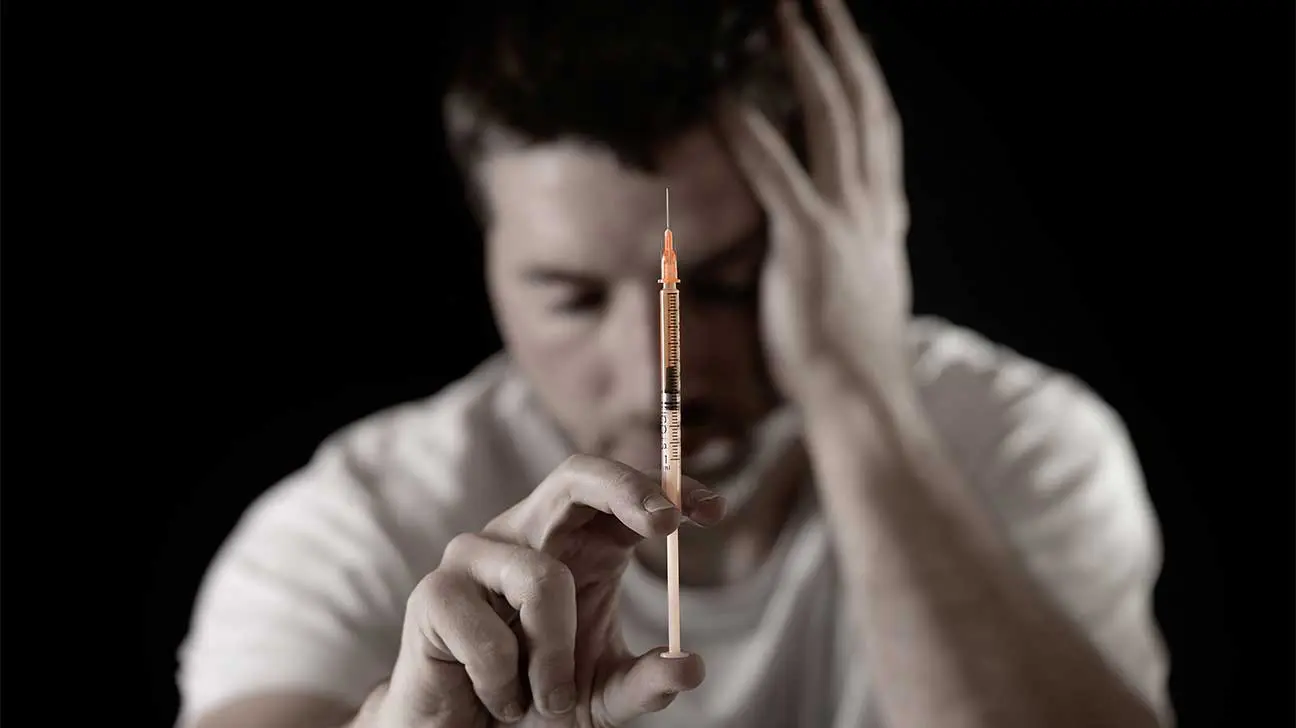Heroin Needle Use: Safe Heroin Injection Through Harm Reduction
Harm reduction strategies have been associated with reduced harm among people addicted to heroin, including those at risk for infection or other health effects due to heroin needle use. Safe heroin injection practices can reduce the risk for diseases, reduce overdose risk, and connect people with addictions with supportive resources.

Heroin is a highly addictive drug used by hundreds of thousands of people in the United States in a given year. According to the National Survey on Drug Use and Health, over 400,000 people had a heroin use disorder in 2019.
One of the primary ways heroin is used is through injection. People can take heroin by dissolving powdered forms of the drug and injecting it into their veins or muscles for a rapid high.
As an illegal opiate drug, heroin has close ties to the United States opioid epidemic, which has taken the lives of more than 450,000 people since 1999. In addition to deadly consequences, heroin is associated with a wide range of health problems, including infectious diseases, infections, mental health problems, and long-term scarring.
In recent years, harm reduction strategies — such as needle safety — which serve to immediately reduce harms posed by drug injection, have become central to substance abuse prevention and treatment efforts across the United States.
What Is Harm Reduction?
Harm reduction refers to a set of practices and policies for minimizing the harms associated with drug use. Unlike most traditional treatment approaches, harm reduction does not immediately push for abstinence or require that a person stops using drugs.
Instead, harm reduction focuses on reducing the immediate harms posed by drug use, including risks for infection, disease, and overdose. According to the National Institutes of Health (NIH), harm reduction strategies can lower and prevent the risk of HIV infection — a major public health issue among injection drug users.
Examples of harm reduction include:
- needle and syringe exchange programs
- drug injection rooms/safe injection sites
- expanding access to naloxone (Narcan) to treat opioid overdose
- non-abstinence based housing for people with addiction
- drug checking
- drug education
- overdose prevention and treatment
Harm reduction is broadly acknowledged as a non-punitive approach to minimizing drug-related harms that recognizes the struggles of people who are addicted to drugs. Harm reduction, for instance, can be especially beneficial for people who lack access to treatment, homeless populations, and individuals who are unable to commit to a drug-free life.
County and state governments across the United States have increasingly moved to implement harm reduction programs, particularly in the wake of the country’s epidemic of opioid abuse and overdose.
Harm reduction programs such as safe needle exchanges, safe sharps disposal sites, and Good Samaritan laws have been critical harm reduction strategies undertaken by local and state governments in Massachusetts and other New England states.
Harm Reduction Strategies For Heroin Addiction
Many harm reduction programs that have been developed and implemented in recent years have focused on addressing the U.S. opioid crisis. This includes reducing harms associated with heroin use and addiction.
Safe heroin injection is one of the primary forms of harm reduction for injection drug users. Safe heroin injection strategies focus on minimizing health risks associated with heroin injection through education and resource provision.
According to the National Harm Reduction Coalition, safe injection strategies include:
- developing safe injection sites where people can inject drugs under medical supervision
- teaching individuals how to properly inject on their own (i.e. reducing harms associated with improper/more dangerous methods such as mainlining)
- teaching aftercare recommendations following injection (intravenous, subcutaneous, intramuscular)
One common concern cited by critics of harm reduction is that it will encourage more drug use. Those who support harm reduction, however, assert that this concern is unwarranted, and that their approach to drug use is pragmatic.
Harm reduction is based on the notion that if drug use can’t be prevented, it can still be beneficial to offer strategies, tools, and resources capable of reducing the risks associated with reckless and uninformed drug use.
Safe Injection Sites
One harm reduction strategy that is being considered in at least 13 sites across the United States is the development of supervised injection sites. These sites, which have been implemented in other areas of the globe, provide supervised settings for individuals to inject drugs safely.
The structure and services offered at these sites can vary. Employees at drug injection sites do not inject drugs themselves, and they do not offer or provide drugs. Services offered at these sites may include educational services, counseling, medical care, and referrals to treatment.
Dangers Of Unsafe Injection
Providing tips, tools, and supervised settings for safe heroin injection can be useful for preventing harms associated with heroin injection.
Unsafe injection practices — e.g. using improper methods, failing to treat injection sites properly, or injecting too much at once — can pose a number of harms, including life-threatening dangers.
Harmful effects and dangers of unsafe injection can include:
- abscesses
- HIV risk
- skin or muscle popping (higher risk with black tar heroin)
- high risk for overdose
- heroin needle scars (i.e. track marks)
- infectious diseases such as hepatitis B, hepatitis C, and cellulitis
- heart attack
- stroke
Many dangerous and long-term effects of heroin use, such as heroin needle infection, can be prevented with informed injection practices.
Learning safer methods of injecting heroin can prevent or reduce the risk for scarring, and reduce the risk of fatal drug overdose, which claims the lives of thousands of people in the United States each year.
General Safe Injection Tips
Groups like the National Harm Reduction Coalition and Harm Reduction International offer resource guides and general information about how to inject drugs like heroin safely.
This includes information about where to inject, how to inject, and how to take care of yourself and heroin needle marks after injection. These groups also provide information on the potential dangers of injection drug use, healthcare tips, and how to spot and treat a heroin overdose.
General tips for safe injection include:
- Avoid sharing needles/syringes/drug paraphernalia with others
- Change the injection location regularly to avoid the buildup of scar tissue
- Clean the injection site with a disinfectant prior to injection
- Have naloxone (Narcan) available
- Stock up on a variety of heroin needle sizes, disinfectants, cotton, and sterile water
- Create a safety plan in the event of negative reactions/overdose
Heroin use and addiction is a dangerous condition that can affect all aspects of a person’s life. If you know someone who is in need of heroin addiction treatment, Spring Hill may be able to help.
Find Treatment For Heroin Addiction In Massachusetts
Spring Hill Recovery Center is an accredited rehab center in northern Massachusetts. We offer residential treatment and intensive outpatient treatment programs for alcohol and drug addiction.
During the COVID-19 pandemic, Spring Hill has continued to provide life-saving treatment for people struggling with heroin addiction and relapse. If you or someone you know in Massachusetts is addicted to heroin and needs help, contact us today for more information about our treatment programs.
- Harm Reduction International — What is harm reduction? https://www.hri.global/what-is-harm-reduction
- Substance Abuse and Mental Health Services Administration (SAMHSA) — Key Indicators of Mental Health and Substance Use NSDUH 2019 Results https://www.samhsa.gov/data/sites/default/files/reports/rpt29393/2019NSDUHFFRPDFWHTML/2019NSDUHFFR1PDFW090120.pdf
- National Harm Reduction Coalition — Getting Off: The Basics of Safer Injection https://harmreduction.org/issues/safer-drug-use/injection-safety-manual/
- VeryWellMind — How Safe Injection Sites Work https://www.verywellmind.com/before-you-inject-drugs-unsafely-22433
- Minnesota Department of Health — Injection Drug Use https://www.health.state.mn.us/communities/opioids/basics/intravenous.html


